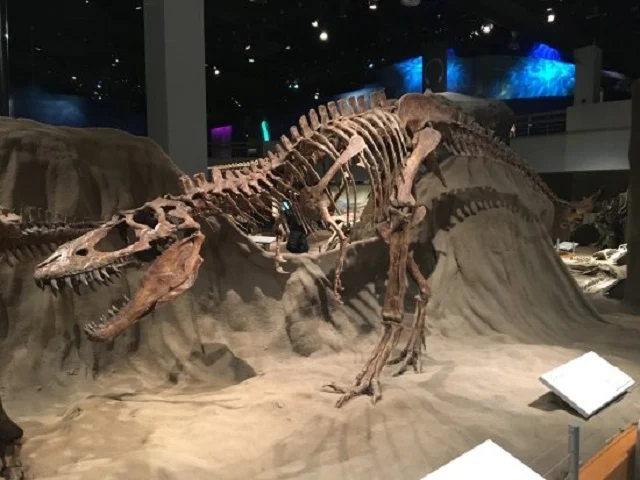Most people know about the city of Calgary in southeastern Canada as the capital of the XV Winter Olympic Games in 1988. Located in the neighborhood - about a hundred kilometers (the population and distances there are about the same as ours in Siberia) - on the banks of the Red Deer River, the quiet and cozy town of Drumheller is still little known.
 |
| Drumheller |
Exotic city of huge reptiles
The most important dinosaur - a sculpture of a prehistoric lizard - can be seen immediately. A huge and toothy reptilian, about 10 meters high, but not at all scary. And the lizard even smiles! As such, he is often the first person welcomed by travelers to Drumheller. But he is far from the only one, but only one of many urban reptiles.
Dinosaurs are everywhere here - in the form of various sculptures and decorations, drawings - on posters and billboards... Even in small shops and cafes, visitors are met and escorted (just not yet served) by small friendly dinosaurs. There are postcards and napkins with their portraits on the windows and tables.
In stores, cute little animals are presented in the widest range: various souvenirs, soft toys, robots, puzzles, sculptures, T-shirts with colorful images... For every taste, color and size.
Such an abundance of ancient reptiles is explained by the fact that six kilometers from the center of this city in the middle of Midland Park is the Royal Tyrrell Paleontological Museum, the main theme of which is just dinosaurs.
Thanks to the museum, Drumheller has already become a center of regional tourism and is gradually gaining popularity. And all kinds of mass demonstrations and various forms and types of exposition characters are not only popular products, but also additional advertising for the museum.
Real dinosaurs
Already in the XIX century, in search of fragments of unusual skeletons and bones, paleontologists-professionals and amateurs began to excavate in these places. After all, the first random finds made it possible to establish for sure that these were the remains of ancient dinosaurs.
Over time, the location of the largest concentration of skeletons was determined - a large valley in the bend of the Red Deer River. In it, later, the city of Drumheller was founded.
The river flows through a flat, soft land that is easily eroded. Therefore, the river constantly deepened its channel, forming a deep canyon. However, in the layers of local soft soils there are quite decent inclusions of rocks.
As the soil was washed away, they came out of the ground and rose above it, reaching in some cases a height of 30 meters, sometimes acquiring bizarre shapes: domes, grottoes or mushrooms. All these natural sculptures are decorated with multi-colored veins, painted in a variety of colors.
In the Midland Park, the river from time to time washes out the bones of dinosaurs, but there is no longer an active search for their remains, because the territory has long been a protected natural area.
Fifty kilometers from the park, downstream of Red Deer, Dynasore Park begins. Its very name comes from the English word dinosaur - dinosaur. And so many dinosaur remains are still being found.
Flowing through the territory of the park, the river makes many sharp turns, meanders, several small rivers flow into it. In all these bends, a large number of washed-out bones and even almost complete skeletons have accumulated.
In ancient times, Red Deer carried the dead bodies of dinosaurs that got stuck in such narrow bends. Then their bodies were covered with silt and sand, so the skeletons were well preserved in sedimentary rocks.
According to some researchers, this is the largest planetary cemetery of prehistoric reptiles. Therefore, back in 1979, the natural complex of the Dainasor Park was declared a UNESCO World Heritage Site.
 |
| Drumheller |
How did the Tyrrell Museum originate?
Famous Canadian scientist, geologist and paleontologist Joseph Burr Tyrrell, who lived for almost 99 years, was a graduate of the University of Toronto. He started his career with a geological company in Ottawa.
Already at the age of 26, in 1884, he led an expedition to the province of Alberta through the territory of Badland - Bad Land - in order to search for deposits of coal. However, dinosaur remains have also been found.
The huge number of remains found made it possible to assemble a good collection, which later became the basis of the exposition of the paleontological museum, the decision to create which the Canadian authorities took in 1955. At the same time, it was decided to declare the area around the future museum a reserve of the Midland Provincial Park.
Tyrrell himself took an active part in the formation of the mentioned collection, despite his very advanced age. The opening of the museum in its original version took place in 1970.
In 1985, the museum moved to a building specially built for it, which freely accommodated the collection, which was significantly replenished with new exhibits, for which there was no longer enough space in the old building.
In 1990, Queen Elizabeth II of Great Britain visited the museum. After this visit, by decree of Her Majesty, the museum received the name Royal Tyrrell Museum (Royal Tyrrell Museum).
Now the museum in the capital of dinosaurs is visited by up to a thousand people a day. There is a real kingdom of prehistoric dinosaurs: fully assembled skeletons, life-size sculptural images. All eras and periods of life of these animals are represented.
Near the museum there is a platform with a telescope that allows you to view the valley, where excavations continue. In the old days, amateur paleontologists heavily damaged the walls of the Red Deer River Canyon. Many dinosaur bones ended up in private collections. But now all these places are a protected area.